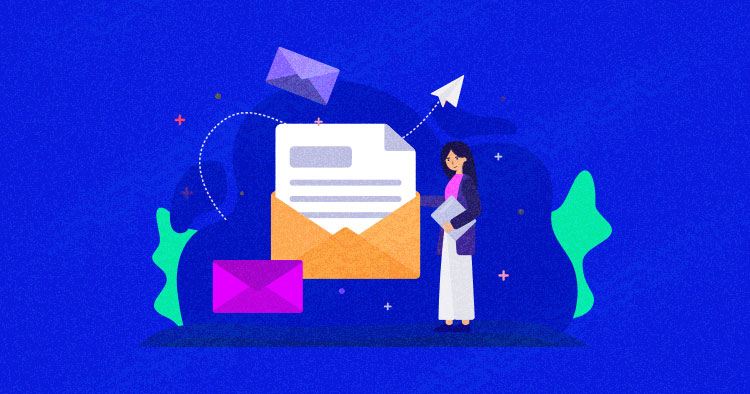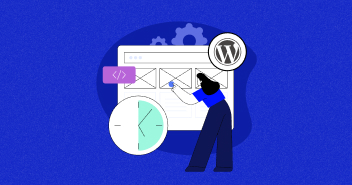
Whether you run email campaigns for sales, marketing, recruitment, or fundraising, your email bounce rate is one of the key metrics to track. When an email you send bounces, it doesn’t just affect the chances of that specific email being read. A high bounce rate harms the probability of future emails reaching their target recipients.
It’s understandable to have some emails bouncing here and there, but if you have too many of the emails bouncing back, it may be time to rethink how you do email marketing. Let’s kick things off by dealing with an important definition.
- What Is Email Bounce Rate?
- Why Do Your Emails Bounce?
- 8 Strategies for Reducing Email Bounce Rate
- Don’t Buy Email Lists
- Don’t Send Spam (or Anything That Looks Like It)
- Clean Your Subscriber List
- Use a Company-Branded Email Address
- Get Your Email Domain Verified
- Secure Permission From Potential Subscribers First
- Be More Consistent in Sending Marketing Emails
- Give Your Subscribers More Control Over the Content They Receive
What Is Email Bounce Rate?
Remember when you send an email and then get a “Message undelivered” message in your mailbox after a few minutes? That notification means your message just bounced. An email bounces when the intended recipient’s email server cannot deliver the message to the intended recipient.

Source: Outfunnel
The email bounce rate is calculated as the proportion of the emails that bounce versus the total number of emails you send. While bounce rates vary across industries, the average bounce rate across all industries is around 1.06 percent. Needless to say, if your bounce rate goes beyond 2 percent, it’s an indication that your email list isn’t as “healthy” as it should be.
Why Do Your Emails Bounce?
There are many reasons emails bounce. Most email marketing experts classify bounced emails into two types: “hard” bounces and “soft” bounces.
A hard bounce refers to an email that was returned to the sender without ever being accepted by the recipient’s email server. Here are three reasons for hard bounces:
- The email address is nonexistent: The address might have been misspelled, or the intended recipient just gave an email address that doesn’t exist.
- The receiving domain does not exist: See above.
- The email server blocks incoming emails: The email server might have been configured to reject emails coming from specific addresses or domains.
On the other hand, a soft bounce refers to an email that goes back to the sender even after getting accepted by the recipient’s mail server. Below are three typical reasons for soft bounces:
- The email message is too large: This depends on the limit imposed by the recipient’s server. Most legacy systems have very low limits, while some cloud-based email platforms have larger storage.
- The recipient’s email server is offline: The server might be undergoing maintenance or the network connection is not working.
- The recipient’s inbox is full: One study showed that Friday and Saturday are the worst days for email bounce, with 0.8 percent of all emails bouncing on those days. This is probably due to an entire week’s worth of email accumulating in inboxes – maybe including your marketing emails for the past week.
The six primary reasons above will determine your strategies for reducing your email bounce rate.
8 Strategies for Reducing Email Bounce Rate
If you find that your email bounce is not at a healthy level, you will need to take steps to address it. Here are eight ways to reduce your email bounce rate and improve your email deliverability rate, open rate, and click-through rate.
1. Don’t Buy Email Lists
If you’re just starting out, it’s quite tempting to buy email lists from third-party vendors, especially if you’re in a hurry to launch a product and don’t have time to get new organic subscribers. Buying email lists is not just illegal in certain locations, it’s also very risky.
Moreover, if you buy an email list might pay a lot of money for nonexistent email addresses or fake email. Furthermore, some email servers are set up to reject emails coming from unknown sources automatically. Even if your emails go through, your recipients are likely to mark you as spam.
Buying email lists is a convenient way of building your subscriber list, but we don’t recommend it. At best, your emails might end up in the spam folder. At worst, you could face hefty fines and criminal charges for using potentially stolen data.
2. Don’t Send Spam
Before you hit “send” on an email campaign, ask yourself: “If I was the recipient, would I want to read this?” If you can answer yes without hesitation, go ahead and send it. Otherwise, you need to go through the email again.
Email servers use a variety of methods to determine whether an incoming message is a spam.
- Subject lines: Spam filters look for certain words that appear most on spam emails. These include “Online biz opportunity”, “viagra”, “meet singles”, “100 percent guaranteed”, and “You’ve been selected”. If you feel your subject lines are consigning your messages to the spam folder, you may be using suspect terms.
- Greetings: Legitimate businesses know the value of personalization, and when an email uses the recipient’s first name in the greeting, it’s probably from a legitimate source. In contrast, spam emails are likely to start with something generic.
- Content: Does your email ask for personal data? Are the images low-resolution? Is the text riddled with typos and grammatical errors? Is the font Comic Sans? If it looks and sounds spammy, it probably is.
A well-written email will look and feel professional. Furthermore, you’re less likely to mark relevant content as spam.

Always aim to send emails that you would like to receive if you were the subscriber.
3. Clean Your Subscriber List
Even if all the email addresses were acquired through legal means, you’ll probably start getting bounce notifications after a few months. This phenomenon, called “database decay”, is a normal part of the marketing industry and happens for reasons beyond control.
These reasons include:
- People leaving their jobs: Many people use their company email addresses to sign up for your marketing emails. When they leave their jobs, their inboxes become inactive and are gradually deleted.
- Domains being renamed or deleted: Companies close down, get acquired by other companies, or rename themselves. The same can also happen to their email domains.
- Voluntary deactivation: People can delete their email accounts voluntarily. They may also stop using an old email address altogether and let it go past its storage limit. Either of the two will result in bouncing emails.
There is nothing you can do to prevent database decay.
You can clean up your email database to ensure that it only has active email addresses. You may use an email verification tool or list cleaning software for the best results. There are plenty of great email verification tools. One of the market leaders is ZeroBounce, but there are plenty of alternatives such as BriteVerify or Bouncer
For other pieces of advice on how to run effective email campaigns, check out this guide about email marketing best practices.
4. Use a Company-Branded Email Address
Let’s face it. You’re not going to convince everyone that you’re running a legitimate business if your email address ends in “@yahoo.com”. It just looks unprofessional. There is no excuse for not getting a business email address with domains and storage available at very low prices.
Aside from not looking professional, many email servers, especially those linked to corporate accounts, are set up not to accept emails from addresses that end in “yahoo.com”, “hotmail.com”, or “gmail.com”. Getting a dedicated email address just makes sense if you’re planning to grow an email list.
5. Get Your Email Domain Verified
If you’ve got a company-branded email address, it’s a good time to verify your domain. Verifying your domain will tell receiving email servers that your domain is legitimate and that you’re seeking the servers’ permission to send emails to addresses that belong to them.
Litmus estimates that less than 40 percent of businesses authenticate their domains. Most businesses that do get their domains authenticated using one or more of three main methods: DMARC, DKIM, and SPF.
Email domain verification helps the receiving email server identify legitimate emails from authorized sources. It also helps servers reject unauthorized emails from senders that “spoof” authorized addresses.
Besides protecting both your recipients and the emails you send, verifying your domain through DMARC or similar verification services will help you collect statistics about your email campaigns. For example, you can find out how many of your messages are passing authentication checks.
Some DMARC.org members are also working on an initiative that seeks to indicate that an email comes from a branded account, similar to the “verified” check marks you see on social media. Google’s Gmail service has already started rolling out a “gold key” indicator displayed next to verified messages from specific email addresses.
6. Secure Permission From Potential Subscribers First
The best way to keep bounce rates low is to get permission from users when they sign up for your mailing list. This email marketing best practice ensures that the people on your list are interested in what you have to say. It’s also a legal requirement for email marketing in some countries.
You might ask, How do I get permission from my subscribers? Isn’t it enough that they’ve signed up for my list? While a single opt-in process will grow your list faster, it’s also a lot riskier. Your list could be populated by spambots, users that add email addresses that aren’t theirs, or email addresses that don’t exist (or have typo errors).
On the other hand, a double opt-in will require a subscriber to open a confirmation email with a verification link that they should click. This single extra step will ensure that your subscribers enter their email addresses correctly, reduces the possibility of them marking your emails as spam, and increases your open and click-through rates.

The confirmation email above, from the “Pottermore” online world, asks the subscriber to click on a link so it can validate their account. This ensures that only real users can access and explore Pottermore.
The double opt-in method’s main disadvantage is that roughly 20 percent of your initial subscribers won’t complete the confirmation step. However, that’s a small price to pay for a subscriber base that is more receptive to your messages.
7. Be More Consistent in Sending Marketing Emails
People tend to be suspicious of emails coming from sources they’re not familiar with. In contrast, your audience will tend to trust you more if you send emails regularly. Sending regular emails will also help you discover which email addresses are still active. People will abandon old addresses and change their existing ones.
Try to set a regular schedule for sending emails. Apart from anything else, that regular contact will help you create a bond with your subscribers.
Another thing you should do is respond to any emails you receive from subscribers. After all, we use emails to have conversations. Interactions with your subscribers will show that you’re not engaged in a one-way conversation.
8. Give Your Subscribers More Control Over the Content They Receive
Your subscribers are more likely to open your emails if they contain information that’s relevant to them. On the other hand, they are more likely to ignore emails that don’t contain information they consider useful.
One way to prevent this is to ask your subscribers upfront about their interests during the signup process. For example, Amazon asks its customers to tick off boxes next to their interests when they register:

Your subscribers are going to change their minds sooner or later, though. The least you could do for them is to give them away to update their preferences – or opt-out of your list altogether.
Giving your subscribers the option to change their preferences will help ensure the content they receive is relevant to their interests. Ultimately, the more relevant the content, the higher the chance that they keep reading your emails. Furthermore, the option to change preference is required by law in some regions.
Wrapping up!
It’s perfectly natural to get a few bounced emails now and then. As soon as you encounter a spike in your bounce rate, it’s time to take immediate action.
A high bounce rate is usually a sign that your subscriber list needs to be cleaned, your campaigns need to be written and built better, or your subscribers are no longer interested. Putting yourself in your subscribers’ shoes will help you realize what you need to do or change to keep your email bounce rate at a manageable level. A mixture of common sense and following the tips I shared above will help you overcome any problems.
Note: This article was published in collaboration with Michal Leszczynski, Head of Content Marketing and Partnerships at GetResponse.
Q. What is a good bounce rate for email?
A good bounce rate for email is typically below 2-3%. However, the ideal rate can vary depending on factors like industry and campaign type.
Q. What causes the bounce rate in emails?
Email bounce rate can be caused by various factors, including invalid email addresses, server issues, spam filters, and sender reputation.
Q. How do I stop emails from being bounced?
To prevent emails from bouncing, maintain a clean and updated email list, use double opt-in methods, authenticate your emails with SPF, DKIM, and DMARC, and monitor your sender reputation.
Q. How can you reduce the bounce rate?
You can reduce email bounce rate by regularly cleaning your email list, segmenting your audience, personalizing your emails, optimizing email content and design, testing email deliverability, and monitoring and improving sender reputation.
Q. Should the email bounce rate be under 1%?
While an email bounce rate under 1% is often considered excellent, it may not be achievable for all campaigns. You should aim to keep your bounce rate as low as possible while considering industry standards.
Mansoor Ahmed Khan
Been in content marketing since 2014, and I still get a kick out of creating stories that resonate with the target audience and drive results. At Cloudways by DigitalOcean (a leading cloud hosting company, btw!), I lead a dream team of content creators. Together, we brainstorm, write, and churn out awesome content across all the channels: blogs, social media, emails, you name it! You can reach out to me at [email protected].


